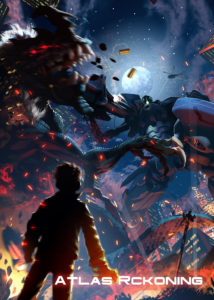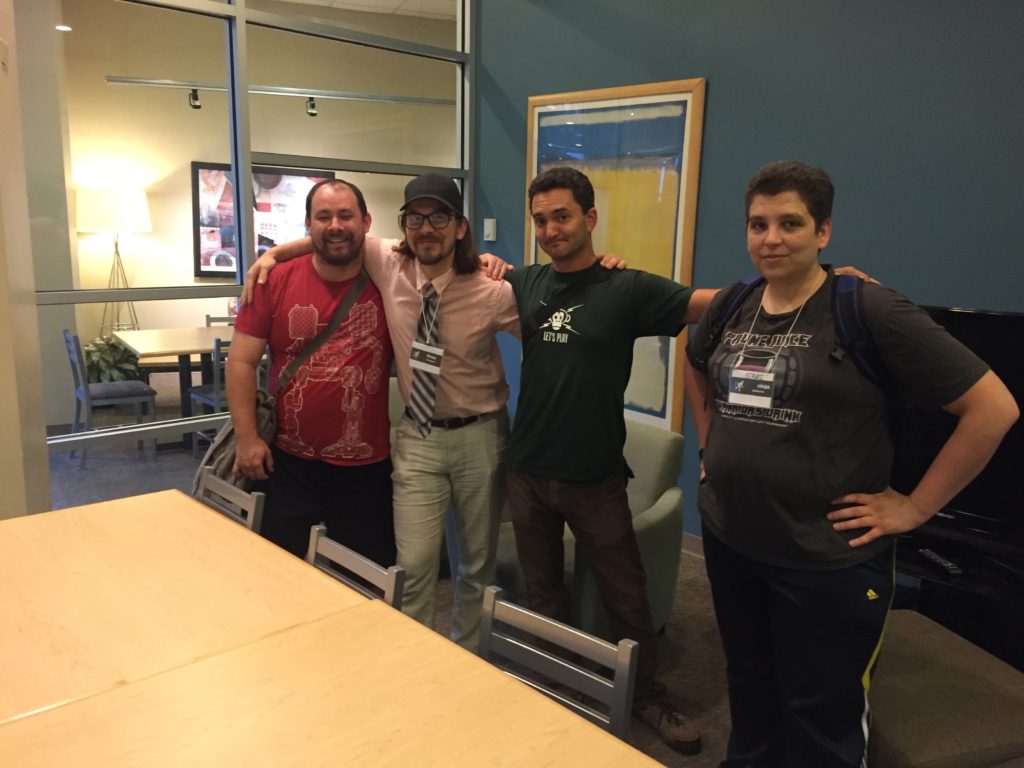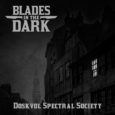 GM: Stras Acimovic
GM: Stras Acimovic
Players: Lucian Smith, Tomer Gurantz, Ross Cowman, and Sean Nittner
System: Atlas Reckoning
I almost missed this game. Stupidly, stupidly, I almost missed it. Stras specifically offered it in the only slot I didn’t have a game so I could play it (as I had asked him to run it for me before). I gave Stras this half-ass “maybe” answer because I wasn’t sure if I wanted to geek out about cons with Jonh Powel, or have a late dinner, or otherwise just relax after all the great games.
In the middle of dinner though, my senses came back to me. I had asked Stras to run Atlas. He was running it in a slot I could play in. I WANTED TO PLAY THIS GAME. I AM VERY GLAD I PLAYED THIS GAME.
Questions
Because he’s a genious, Stras starts the game off by telling everyone we’re going to pilot giant mecha to fight off some threat. And we all, understanding modern science know that using giant robots is probably not the most cost efficient or effective way to do anything, but that is what this game is about, so the game starts off asking:
What is the thing which threaten humanity and why are giant fighting robots the only way to stop it?
It’s baked right into the game. Before we even start playing we, as players, have invested in why we’ell be doing this thing. There are a couple of other questions, but those were the big ones for me. In our case water levels had rises and most of humanity was underwater. The kaiju that attacked us would irradiate any place they died in, if not for the Atlas core engine that could absorb the energy as it bled out of the. YES!
Character Creation
There are a lot of playbooks that look exactly how you’d expect them to. The Rookie, The Scientist, The Engineer, and The Hotshot are the ones we picked. Each playbook has it’s own moves (as would be expected) but they also have moves tied to how they fight in an Atlas. Some lean towards offensive builds, some towards defensive, and some towards tactical. Within each of those trees, there are special abilities that reinforce the theme.
I could tell already that Stras took some of the principles from Apocalypse World when developing the game but specifically dialed the focus back so that the character was not the entire focal point of the game. The characters relationship with their fellow pilot, the Atlas itself, and the world they were saving were all integral parts of the game. So much love for all of this.
We had the grandson of the creator of an atlas. A hotshot pilot who was a genetic experiment and her much more cerebral daughter, and the rookie Kevin, who just made it onto the team.
Atlas Creation
It’s like gun porn without counting the bullets. Each Atlas could be equipped with various sensors, defensive equipment, and, weapons, each of which had cool mechanical effects when used in play. They could even be doubled down on for more delicious goodness.
When all the goodies were picked, the two pilots (a Atlas must have two pilots who’s brains are synced during the piloting) simultaneously said one word, and combining those we got the name of our Atlas. Ross and I piloted “Dagger Dragon”. Sweet!
 Kicking off the game
Kicking off the game
The game starts with all us doing our opening montage. Describing our characters. What we do, what the base looks like, how we interact with others. Then the alarms go off and we suit up, which is another montage of how we get inside our Atlas and in our case out into the water!
The sync
This part is super cool and I’d like to see more of it throughout the game. Each pilot that shares a mech draws a hand of cards (normal playing cards) and then passes two cards to their co-pilot. Without talking then each pilot plays a card. If the card does not match at all they have no sycn. If the cards match in color only (back or red) they have weak sync, if the cards match in suit they have normal sync, and if the number of the cards match, they get strong sync! This effects how much you can do with your mech once you get out there and start fighting.
Also, possibly more importantly, whichever of the two pilots plays the highest card gets to ask the their co-pilot a questions based on the suit of the card. The question is answered by a memory that is shared between the two pilots as they sync. So many damn feels here. I love it!
Fighting monsters
The card mechanic of the game is more complicated that I can capture now but hands down it’s one of the more extensive and well thought out card mechanics I’ve seen for representing tactical combat maneuvers. Between the cards themselves, our own moves, special equipment on the Atlas, and the monsters special abilities…. wow, there is so much there. And none of it feels clunky!
We finished off our foe talking only minimal stress to ourselves and bringing our fighting robots back in tact. We didn’t kill the tentacle monster as quickly as we could though because I, playing the hotshot, held off a moment so I could deliver the killing blow, and earn a new move for my shenanigans!
Downtime
Back at the base, each player picks a location like sick bay, the war room, engineering, etc. and frames a scene there. They have a few questions about the location they have to answer, which helps flesh out the world, and they are also rewarded for taking certain acts (like lashing out at someone for no good reason) by either allowing them to recover stress, gain additional cards in a future fight, or otherwise tend to their narrative and mechanical needs. Since each player in each scene can satisfy different requirements, the game encourages players to frame scenes with each other so everyone can benefit from them. This remind me a lot of the recover phase in Agon, Downtime in Blades in the Dark, and Player turns/Camp in Mouse Guard/Torchbearer. Go figure Stras has some awesome sources of inspiration!
We ended the game with downtime complete, and all of us ready to go back into the fray, even though we knew some pretty grim things about each other…and the monsters we were fighting.
What Rocked
A whole heck of a lot, but specifically:
- The Sync mechanic. I want to see more of this!
- Building your Atlas. Gearing it out, picking your moves and your focus.
- The fight mechanics were fantastic. Lots of really great options for different styles of play.
- The character focus into offensive, tactical, and defensive options, which all led to cool moves. Most notably the defensive moves didn’t just negate attacks/damage, which is how they usually work in a lot of games and is also why I never take them, because negation is super boring.
- The artwork and graphic design for the Atlas. There is a lot of information there and it’s displayed really clearly!
- The feels! Asking each other deep dark secrets as the way you power your Atlas is fucking awesome. So good.
- Our character tension. I felt like even in a fighting game I had a lot of personal investment in the other characters. My co-pilot the Rookie wanted to impress me. My daughter the scientist was avoiding me, and her co-pilot the engineer infuriated me so much I almost broke his jaw because he was paying attention to the tech instead of the fight at hand and had put my daughter in danger because of it! Good stuff.
What could have improved
- Like a lot of games in development, play was very paper heavy. A sheet for our characters, a sheet for out Atlas. A sheet with how the various equipment works, and a sheet for every location we could frame scenes in. I think this is natural part of game development and as you play more and more, you figure out how you can run with fewer pieces of paper on the table at any one time.
- Tomer pointed out that downtime presented too many options to try and capture and that a starting mission might benefit from a truncated version where there were few options available until the players became acclimated to the game.
- Ever since talking to Ross about component based design, I keep looking at games and wonder how they components could improve play. In this case I think there as specifically things like having cards for equipment that can be placed in specific slots so its clear what fits where, as well as linking some of the moves to physical components so that their effects were visible on the table. I really, really want Stras and Ross to sit down together over this because I think that Ross could take this beautiful system Stras has created and make it even more accessible to players.
I really want to play this game over and over. Like a lot. As soon as we were done with the mission I was like, lets do it gain! I had the same kind of enthusiasm for it that I did when I played Dungeons & Dragons in high school. I just wanted to keep playing and see what happened. I wanted to learn mastery over the mechanism. I wanted to find out more secrets. More, more, more, more!


